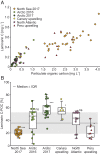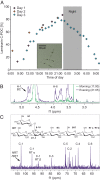Laminarin is a major molecule in the marine carbon cycle
- PMID: 32170018
- PMCID: PMC7104365
- DOI: 10.1073/pnas.1917001117
Laminarin is a major molecule in the marine carbon cycle
Abstract
Marine microalgae sequester as much CO2 into carbohydrates as terrestrial plants. Polymeric carbohydrates (i.e., glycans) provide carbon for heterotrophic organisms and constitute a carbon sink in the global oceans. The quantitative contributions of different algal glycans to cycling and sequestration of carbon remain unknown, partly because of the analytical challenge to quantify glycans in complex biological matrices. Here, we quantified a glycan structural type using a recently developed biocatalytic strategy, which involves laminarinase enzymes that specifically cleave the algal glycan laminarin into readily analyzable fragments. We measured laminarin along transects in the Arctic, Atlantic, and Pacific oceans and during three time series in the North Sea. These data revealed a median of 26 ± 17% laminarin within the particulate organic carbon pool. The observed correlation between chlorophyll and laminarin suggests an annual production of algal laminarin of 12 ± 8 gigatons: that is, approximately three times the annual atmospheric carbon dioxide increase by fossil fuel burning. Moreover, our data revealed that laminarin accounted for up to 50% of organic carbon in sinking diatom-containing particles, thus substantially contributing to carbon export from surface waters. Spatially and temporally variable laminarin concentrations in the sunlit ocean are driven by light availability. Collectively, these observations highlight the prominent ecological role and biogeochemical function of laminarin in oceanic carbon export and energy flow to higher trophic levels.
Keywords: carbon cycle; diatoms; diel cycle; glycans; laminarin.
Copyright © 2020 the Author(s). Published by PNAS.
Conflict of interest statement
The authors declare no competing interest.
Figures





Similar articles
-
Accurate Quantification of Laminarin in Marine Organic Matter with Enzymes from Marine Microbes.Appl Environ Microbiol. 2017 Apr 17;83(9):e03389-16. doi: 10.1128/AEM.03389-16. Print 2017 May 1. Appl Environ Microbiol. 2017. PMID: 28213541 Free PMC article.
-
Biocatalytic quantification of α-glucan in marine particulate organic matter.Microbiologyopen. 2022 Jun;11(3):e1289. doi: 10.1002/mbo3.1289. Microbiologyopen. 2022. PMID: 35765187 Free PMC article.
-
Biological composition and microbial dynamics of sinking particulate organic matter at abyssal depths in the oligotrophic open ocean.Proc Natl Acad Sci U S A. 2019 Jun 11;116(24):11824-11832. doi: 10.1073/pnas.1903080116. Epub 2019 May 24. Proc Natl Acad Sci U S A. 2019. PMID: 31127042 Free PMC article.
-
The Minderoo-Monaco Commission on Plastics and Human Health.Ann Glob Health. 2023 Mar 21;89(1):23. doi: 10.5334/aogh.4056. eCollection 2023. Ann Glob Health. 2023. PMID: 36969097 Free PMC article. Review.
-
Structures and functions of algal glycans shape their capacity to sequester carbon in the ocean.Curr Opin Chem Biol. 2022 Dec;71:102204. doi: 10.1016/j.cbpa.2022.102204. Epub 2022 Sep 22. Curr Opin Chem Biol. 2022. PMID: 36155346 Review.
Cited by
-
Dissolved storage glycans shaped the community composition of abundant bacterioplankton clades during a North Sea spring phytoplankton bloom.Microbiome. 2023 Apr 17;11(1):77. doi: 10.1186/s40168-023-01517-x. Microbiome. 2023. PMID: 37069671 Free PMC article.
-
Diatom fucan polysaccharide precipitates carbon during algal blooms.Nat Commun. 2021 Feb 19;12(1):1150. doi: 10.1038/s41467-021-21009-6. Nat Commun. 2021. PMID: 33608542 Free PMC article.
-
Particle-attached bacteria act as gatekeepers in the decomposition of complex phytoplankton polysaccharides.Microbiome. 2024 Feb 20;12(1):32. doi: 10.1186/s40168-024-01757-5. Microbiome. 2024. PMID: 38374154 Free PMC article.
-
Physiological and morphological plasticity in response to nitrogen availability of a yeast widely distributed in the open ocean.FEMS Microbiol Ecol. 2024 Apr 10;100(5):fiae053. doi: 10.1093/femsec/fiae053. FEMS Microbiol Ecol. 2024. PMID: 38599628 Free PMC article.
-
Extensive Microbial Processing of Polysaccharides in the South Pacific Gyre via Selfish Uptake and Extracellular Hydrolysis.Front Microbiol. 2020 Dec 18;11:583158. doi: 10.3389/fmicb.2020.583158. eCollection 2020. Front Microbiol. 2020. PMID: 33391202 Free PMC article.
References
-
- Field C. B., Behrenfeld M. J., Randerson J. T., Falkowski P., Primary production of the biosphere: Integrating terrestrial and oceanic components. Science 281, 237–240 (1998). - PubMed
-
- Biersmith A., Benner R., Carbohydrates in phytoplankton and freshly produced dissolved organic matter. Mar. Chem. 63, 131–144 (1998).
-
- Engel A., Thoms S., Riebesell U., Rochelle-Newall E., Zondervan I., Polysaccharide aggregation as a potential sink of marine dissolved organic carbon. Nature 428, 929–932 (2004). - PubMed
-
- Aluwihare L. I., Repeta D. J., Chen R. F., A major biopolymeric component to dissolved organic carbon in surface sea water. Nature 387, 166–169 (1997).
-
- Teeling H., et al. , Substrate-controlled succession of marine bacterioplankton populations induced by a phytoplankton bloom. Science 336, 608–611 (2012). - PubMed
Publication types
MeSH terms
Substances
LinkOut - more resources
Full Text Sources
Other Literature Sources

